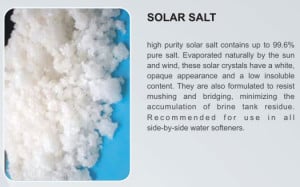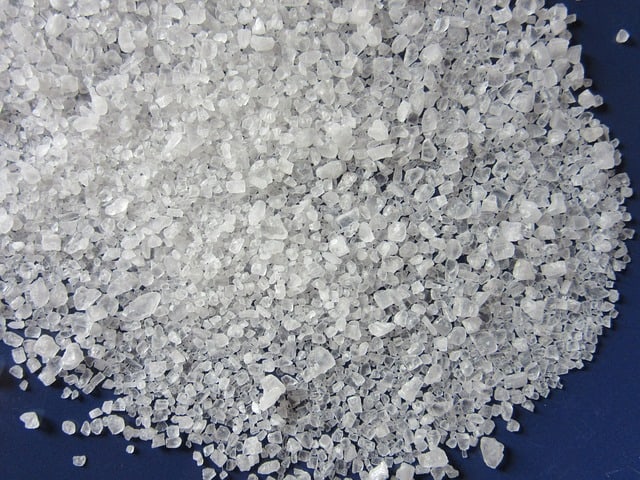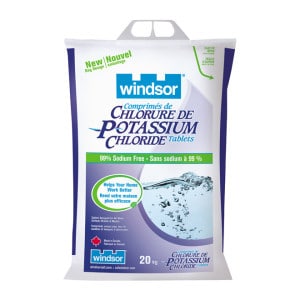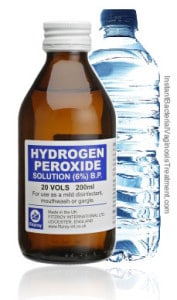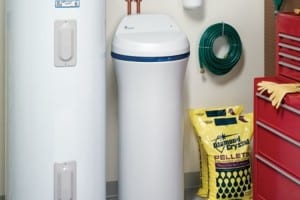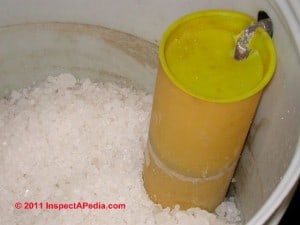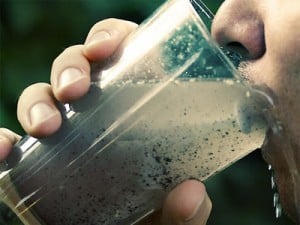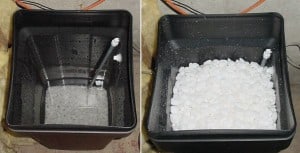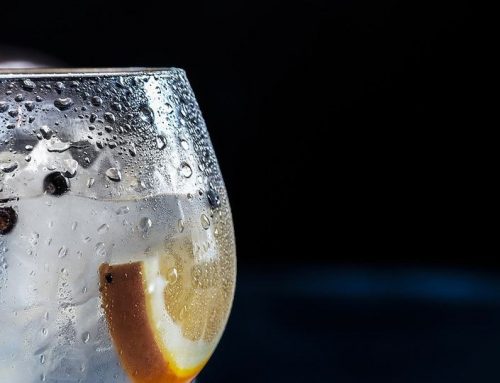Good day readers! More often than not, people are not really sure about what kind of water softener salt to use for their water softeners. And we can’t really blame these people from missing out on this detail because although the internet is packed with a lot of reviews concerning water softener devices, there is so little information being relayed about using the right kind of softener salt that we feel the need to do something about it.
Without further ado, we encourage you to go on reading as we are going to tackle all the things we need to know about salt for water softener devices. This article is created so that readers will be thoroughly educated on the importance of choosing the right type of softening salt. Two primary factors will be the system you have and personal preference regarding particular features.
Water Softener Salt Types
Currently, there are 5 water softener salt types being used by most consumers today. These are rock salt, solar salt, evaporated salt, and the typical “salt” alternatives in potassium and salt infused with hydrogen peroxide. Let us look closely into each of these softening agents so we can better understand their value for softening water.
1. Rock Salt
Rock Salt is basically a kind of salt that is usually mined underground. These minerals are formed through the accumulation of salt deposits as a result of soil erosion due hundreds (if not, thousands) of years of rains and other underlying factors. Rock salt is the rawest kind of salt among the 5 since the salt crystals also contain other traces of minerals which may not be dissolved in water. Now is it practical to choose this type of salt for softening water considering that it also has other minerals aside from sodium chloride? While it’s true that rock salt also contains insoluble elements in each crystal, there isn’t really an issue about continuously using this in your water softners. After all, softener brands still manufacture this kind of salt for water softener use until today. You just have to bear with the fact that you’ll have to do frequent cleaning as the added minerals in salt crystals are usually left behind inside the brine tank.
2. Solar Salt
Solar salt or sea salt on the other hand, is another form of salt that is used in softening water. Solar salt is a by-product of evaporated seawater which is usually collected at a certain area and left there to dry. Once salt crystals begin to appear, they are harvested in baskets and shipped to the market for various use. Solar salt has a high solubility rate. Meaning, it has the ability to be dissolved faster compared to its water softener salt counterparts. The ones that are used for softening water are usually sold in pellets.
3. Evaporated Salt
Evaporated salt is the purest form of sodium based salts that can be used for softening water. This type of salt is dissolved from its raw state and then converted back into sodium chloride by extracting all the moisture using heat. What is left is 100% pure salt that is very effective in treating hard water.
4. Potassium
Potassium is considered as a healthy substitute for softening water. The use of this element became popular when most of the consumers are becoming aware about the dangers of having too much salt in water which was supposedly “added” by some of the best water softening devices after the softening treatment. The use of sodium based softeners can be traced back in the early 1900’s when a certain German scientist was able to discover the effectiveness of sodium chloride for getting rid of ‘hard’ contaminants in water. The use of salt as a softener salt became a common practice for decades until a handful of consumers in 1980’s began speculating about the negative effects of added salt in water as purportedly done by water softeners systems.
This issue was even brought into attention to the public when findings of a certain study pointed out on the significant effects of increased sodium intake in hypertensive patients because most of the respondents turned out to be water softener users. To make the long story short, potassium was discovered by water softening companies as a potent water softener salt alternative since this element is also a kind of salt but is healthier since it is also considered as a necessary nutrient to keep our bodies healthy. Since then, potassium softening regenerants have been manufactured so that healthy conscious would not have to worry about drinking soft water that is being treated by water softeners.
5. Hydrogen or Hydrogen Peroxide
Hydrogen or hydrogen peroxide is not a type of salt but more of a chemical compound, but it can also be used for treating hard water. Hydrogen peroxide is known to be an effective chemical cleaning agent in eliminating germs in bacteria (disinfectant). That’s is why some homeowners tend to add small amounts of this chemical in their drinking water to make sure that all the harmful microorganisms are killed. So how can it be used for softening water? Easy! All you need to do is add this chemical with along your existing softening regenerant and you can instantly disinfect the water while removing the calcium and magnesium ions at the same time. Think of it as your one-two punch for filtering hard water. And while some consumers prefer this type of softening agent for treating hard water, there are still some who cannot bear to have this regenerate in their brine tanks because of the reported bland after taste that is also produced while softening hard water. Hydrogen softeners are recommended for health-conscious and eco-friendly people who do want to spend more time doing water softener maintenance all the time.
Is Having Too Much Water Softener Salt Something To Be Worried About?
Home water softener units are invented to enhance the quality of water being used at every home. And although the device is created to promote further development in terms of home living, sometimes people cannot help but raised concerns about the process involved in softening water. And one of the most prevailing issues when you talk about this reality is the purported risks that we can get out of drinking soft water.
We have heard about this issue time and again even if we have already established the fact that the process of softening water usually involves sodium chloride from our previous article. In fact, the use of sodium based salts has been as standard for whole house water softener appliances for decades because of their proven efficiency. But does it always follow that having salt in the treatment process can also lead to possible health risks?
How much salt in water is deemed safe for human consumption? Is having “too much” salt in the water something to be worried about? Let’s straighten out all these facts to help you get rid of all your worries concerning drinking soft water once and for all.
As water softener owners, we have to understand the fact that there is no excessive amount of salt being added after every treatment process. As mentioned in our main article, hard water deposits like calcium and magnesium switch places with the sodium ions in the water softener resin. So this means the amount of salt being added into the water is dependent on the hardness of the water that is being supplied to you. Of course, we also have to consider the amount of salt that is already present in the water before the treatment takes place and these elements will comprise of the total amount of salt in water.
According to most studies conducted on the best water filter system units, a standard water softening device will only yield about 113.7 mg of salt per gallon after every regeneration cycle. That is 7.11 mg of sodium per glass which is lower compared to a can of diet soda (24-48 mg) and is almost negligible compared to the amount of salt found in a sliced bread (100g). And if we try to analyze everything based on these results, any person who will drinks soft water the whole day (about 8 glasses) will not suffer from heart attack or kidney disease eventually (provided he or she is maintaining a well-balanced diet) because the amount of salt in the soft water is well within the recommended limits of daily sodium intake (500 mg – 2300 mg). Hence, we can safely say that drinking soft water is not really an issue since the amount of salt that is supposedly added is very very low.
Nevertheless, the idea of having salt in water can be very bothering to some consumers especially to those who are already suffering from kidney and heart related diseases. So if you’re still not convinced with the facts being tackled here then you can also go for the safer choice and that is by using potassium as a water softener salt alternative or replacing your entire system with any of the salt free water softeners available in the market today.
How To Properly Check The Softener Salt Levels In Water Softeners
Refilling the brine tank with salt is one of the trickiest things the deal with when you own a soft water system. It may appear simple at first, but it actually involves a meticulous process in order to ensure that your device will produce the right kind of soft water that you require for your household (based on your preference). If you’re having some concerns with this process as well as having doubts as to how much salt should be placed inside the tank, then don’t fret because we are going to provide all the answers you need in order to perform proper salt management every time you need to do it:
Be familiar with your tank’s function and location
Perform the Softening Salt Management process
In order to check for the proper level of salt inside the tank, all you need to do is open the lid and see for yourself. Ideally, proper salt levels should be maintained at a point where the water at the bottom is not to be seen. If water begins to appear, then this is a sign that your supply of salt for water softener inside the tank is running out and you need to replenish it soon. Most experts recommend that you fill the tank with one bag of salt regenerant. Use only high quality of salt regenerant pellets instead of salt crystals as much as possible to avoid any unwanted deposits from accumulating inside the tank (as mentioned above).
Other Tips to Remember
At times, we may experience “salt bridging” inside the tank. Salt bridging in a hard water filter system is the amassing of salt crystals around the surface of the tank due to excessive salt replacement and improper maintenance. Having this inside your tank can actually affect the quality of soft water being produced as this will prevent you from filling the right amount of softener salt regenerant as required. If you are having trouble with salt bridging today, then we highly recommend that you refill the tank only halfway through so the tank can consume all the fixed salt crystals upon regeneration. And if this won’t solve your problem, then maybe it’s better to do a tank clean up and get rid of these unwanted salt formations manually or call a resident plumber for further assistance.
Maintenance Tips For Your Softener Salt Tank
Inspect the salt level as this is essential
The tank’s consumption of salt
Stains in Water
- The type of softener salt you are using is rock salt. And based on the information given above, we now know that this type of salt also includes traces of insoluble elements which cannot be dissolved in water.
- Incorrect ways of refilling which may result in the inclusion of unwanted deposits as you refill the tank with water softening salt.
- Leakage on water softener parts which can serve as a passageway for the dirt elements to enter into the tank and compromise the quality of soft water being produced.
The accumulation of dirt in small amounts can be considered insignificant, but it can cause a great deal of problems especially if you delay the tank’s maintenance and clean up.
Slimy Water
Has a ‘rotten egg’ kind of smell
- Your water supply has too much sulphur in it and it has to be removed by using another kind of water filtering device that you have now.
- Your water supply is plagued with iron deposits which causes the soft water to have a metallic kind of flavor and/or stench. To get rid of this, you may need to contact your local supplier and inform them about this issue. Aside from that, you can also perform a full tank clean up to remove any iron sediments in your water softener system.
- Your brine tank is contaminated with germs and bacteria in which they can cause the water to render a kind of mossy and seaweed-like stench. If you are experiencing this kind of problem, then all you need to do is to flush out the tank with all salt solution inside and perform a tank clean up. It would also help if you put a little bit of hydrogen peroxide on the water after clean up to prevent this mess from coming back.


